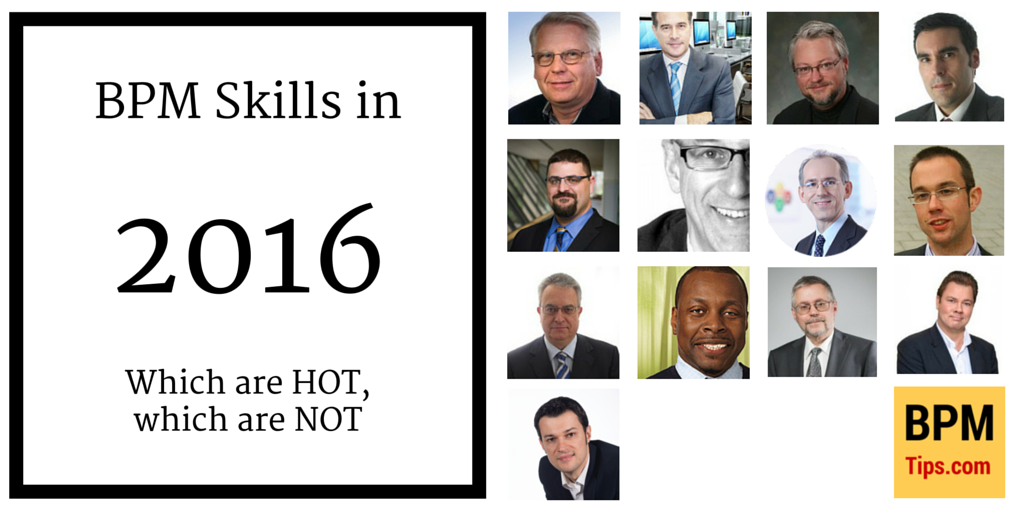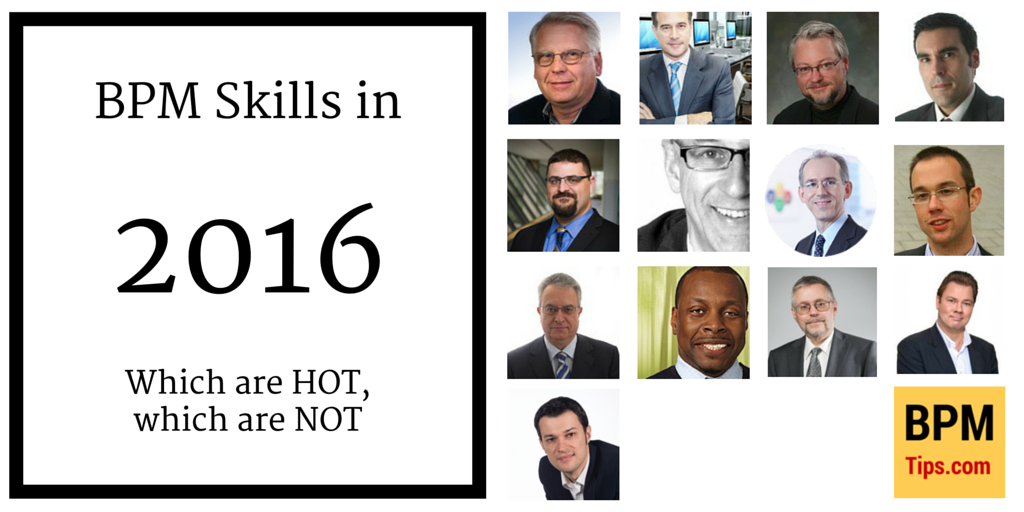Almost every year you can hear about the new standards and topics in BPM that promise you great results. But how to distinguish between new skills you should add to your toolbox, obsolete ones or hypes?
To help you decide what is worth your attention in 2016 I asked some of the best BPM experts in the world two simple questions:
1. What are the skills that BPM practitioners should add to their toolbox in 2016?
2. Which skills are no longer relevant or not practically applicable yet (hype)?
I got 10+ very interesting responses from the experts which should help you decide which BPM skills are hot and which are not.

The post is pretty long, so I have added navigation to make your life easier:
Josep Mª Cos
Lloyd Dugan
Ian Gotts
Harald Kühn
Marcello La Rosa
Alberto Manuel
Nathaniel Palmer
Adrian Reed
Clay Richardson
Pedro Robledo
Alexander Samarin
Jim Sinur
John Tesmer
New version available! Get the “BPM skills in 2017” guide as a convenient, downloadable PDF.
Now, let’s dive into the answers.
Josep Mª Cos
 Josep is a founder of proceedit – “the BPM process factory”. proceedit is Multinational Technology Cluster whose mission is to help their Members Customers to Optimize, Automate and micro-Outsource their Business Processes on a massive way by deploying OPEX-BPM-µBPO solutions. To achieve this we apply principles of co-development, standardization, reuse and co-distribution of our products and services.
Josep is a founder of proceedit – “the BPM process factory”. proceedit is Multinational Technology Cluster whose mission is to help their Members Customers to Optimize, Automate and micro-Outsource their Business Processes on a massive way by deploying OPEX-BPM-µBPO solutions. To achieve this we apply principles of co-development, standardization, reuse and co-distribution of our products and services.
WWW: LI profile
What are the skills that BPM practitioners should add to their toolbox in 2016?
As the key factor for BPM massive deployment is sustainability, and this is strongly related with agility en process changes, skills for knowing how to use dynamic “0” code process application server frames, serving forms for personal tasks on-the-fly, should be “the” must in our days for BPM professionals.
Which skills are no longer relevant or not practically applicable yet (hype)?
Low level language programming skills are becoming obsolete with the irruption of high level dynamic “0” code process application generator frames.
Lloyd Dugan
 Lloyd Dugan is a widely recognized thought leader in the development and use of leading modeling languages, methodologies, and tools, covering from the level of EA and BA down through BPM, Case Management, and SOA. He specializes in the use of standard languages for describing business processes, systems, and services, particularly BPMN, CMMN, and DMN from the OMG. He has developed and delivered BPMN 2.0 training to the U.S. Department of Defense and large consultancies. He has nearly 30 years of experience with public and private sector clients, and has an MBA from the Fuqua School of Business at Duke University. He is an OMG-Certified Expert in BPM (OCEB) – Fundamental, a member of the Workflow Management Coalition and its BPSim Working Group, a member of the OMG’s BPMN Model Interchange Working Group (MIWG), and a Contributing Member (author), Meta Modeling and BPM-BA Alignment Collaboration Teams Member, and Advisory Board Member of the Business Architecture Guild. He is a frequent speaker at national and international conferences on BPM, BPMN, Case Management, SOA, and BA. He is a published author or co-author on BPM, BPMN, and BA. He serves as the Chief Architect for Business Process Management, Inc. (see www.bpm.com), for whom he delivers BPM-related training and client advisory services on BPM-related matters and technologies.
Lloyd Dugan is a widely recognized thought leader in the development and use of leading modeling languages, methodologies, and tools, covering from the level of EA and BA down through BPM, Case Management, and SOA. He specializes in the use of standard languages for describing business processes, systems, and services, particularly BPMN, CMMN, and DMN from the OMG. He has developed and delivered BPMN 2.0 training to the U.S. Department of Defense and large consultancies. He has nearly 30 years of experience with public and private sector clients, and has an MBA from the Fuqua School of Business at Duke University. He is an OMG-Certified Expert in BPM (OCEB) – Fundamental, a member of the Workflow Management Coalition and its BPSim Working Group, a member of the OMG’s BPMN Model Interchange Working Group (MIWG), and a Contributing Member (author), Meta Modeling and BPM-BA Alignment Collaboration Teams Member, and Advisory Board Member of the Business Architecture Guild. He is a frequent speaker at national and international conferences on BPM, BPMN, Case Management, SOA, and BA. He is a published author or co-author on BPM, BPMN, and BA. He serves as the Chief Architect for Business Process Management, Inc. (see www.bpm.com), for whom he delivers BPM-related training and client advisory services on BPM-related matters and technologies.
WWW: BPM.com
WWW: LI profile
What are the skills that BPM practitioners should add to their toolbox in 2016?
BPM Practitioners, particular those involved in modeling, should add the following skill sets to their repertoire:
- Business Architecture (BA). While it is not necessary to become a Business Architect, BPM Practitioners should be come more than just passingly familiar with BA concepts so that they can better participate in business transformation efforts that seek to leverage BA-level artifacts for business capabilities, organizations, information, and value streams. Use of Process Classification Frameworks (PCFs), long considered part of BPM by the OMG in its BPM certification, is much more effective when paired with a BA.
- Case Management Model & Notation (CMMN). OMG’s CMMN is starting to emerge as a real alternative to representing business processes that exceed BPMN’s semantics to describe (or at least what is comprehensible using BPMN semantics). CMMN will prove over time a simpler way of expressing complex operational behaviors in a declarative way that provides a strong basis for analysis.
- Decision Modeling Notation (DMN). Even more than CMMN, OMG’s DMN is now catching fire because a formal basis for modeling rules and decision logic can be done without forcing it into overly complex BPMN models. Often given short shrift in BPM efforts, decision modeling can now step forward as a critical piece of the modeling puzzle for business transformation efforts.
Which skills are no longer relevant or not practically applicable yet (hype)?
Process simulation remains a heavy lift for most folks. If it is done, it is done by Industrial Engineers and Operations Researchers who create custom models and design situation-specific experiments. Simulating business processes by Process Analysts remains the exception, not the rule – largely because the skill set remains untaught and under-appreciated.
It has now been several years since BPSim was developed, around BPMN and XPDL, to provide a standardized basis for process simulation, but only a few brave vendors have embraced it, and fewer BPM Practitioners even bother to learn it. It may become more practical as tooling improvise, though.
Ian Gotts
 Ian is a founder of Q9 Elements, tech advisor, investor, speaker and author.
Ian is a founder of Q9 Elements, tech advisor, investor, speaker and author.
Q9 Elements is a startup software company. It is looking to disrupt the BPM marketplace and enable clients to deliver huge levels of ROI.
WWW: iangotts.com
Twitter: @iangotts
What are the skills that BPM practitioners should add to their toolbox in 2016?
For BPM vendors or IT departments: Engaging business users
The decision making power is now with the line of business, not the IT department. Business Process Management, in its many forms – process modeling, process mapping, automation/workflow and low-code app building – is being purchased and used by business process specialists. These specialists are either in centers of excellence, in the business units, or they are consultants hired by the business units. If you are a BPM vendor or in the IT department you will need to learn the language of business. And this means have an industry knowledge. Banking is not the same as pharma which is not the same as oil & gas. It sounds obvious, but if you are used to operating at a technology level, then you needed to know less about the industry. That has changed.For project sponsors: Building business case with senior management
As technology purchases (or cloud subscriptions) are now made within a business unit, then the decisions will be based on a individual business case. This is different from the IT department deciding on a company wide BPM platform which is used for all projects. But building a business case to improve efficiency or drive better compliance is hard. A business case needs the benefits (cost now minus cost in the future) and the implementation cost (software, services, internal change). None of these are known. In fact, you may need a process project just to establish the baseline costs. So estimating costs and benefits and building credible plans is a skill to be mastered. Without these skills, you will not get your projects funded.
Which skills are no longer relevant or not practically applicable yet (hype)?
Mastering BPMN, UML and BPEL
These modeling notations were important when they were the language which enabled the business analysts and the IT department to communicate BPM/automation/workflow requirements. This was akin to the waterfall development approach.Now the BPMS and low-code app building software is so intuitive that business process specialists, working inside the business units can master them. Therefore they can capture business flows as process maps with simpler notations that end users can understand and validate. And then the business process specialists can use these process maps to build the workflow applications very quickly – in days. And then they can iterate. So this is a lot closer to the agile development approach.
Just as developers no longer need to know assembler to develop applications because of the more sophisticated development languages, process specialists do not need to know complex process notations to specify and build workflow applications.
Harald Kühn
 Dr. Harald Kühn is a member of the management board of the BOC AG. He is responsible for the product and platform development. Dr. Harald Kühn works in the areas of metamodelling, integration of business processes, workflow, and web technologies.
Dr. Harald Kühn is a member of the management board of the BOC AG. He is responsible for the product and platform development. Dr. Harald Kühn works in the areas of metamodelling, integration of business processes, workflow, and web technologies.
He is an author of over 20 publications about various aspects of BPM.
WWW: boc-group.com
Twitter: @BOC_Group
What are the skills that BPM practitioners should add to their toolbox in 2016?
- Business Capability Management
- Integrating BPM with EAM
- BPM and Risk Management
Which skills are no longer relevant or not practically applicable yet (hype)?
- BPEL and WPDL
- Process Mining
Marcello La Rosa
 Professor Marcello La Rosa is the academic director for corporate programs and partnerships at the Information Systems school of the Queensland University of Technology (QUT) in Brisbane, Australia.
Professor Marcello La Rosa is the academic director for corporate programs and partnerships at the Information Systems school of the Queensland University of Technology (QUT) in Brisbane, Australia.
His research interests span different BPM areas, including process consolidation, mining and automation, in which he published over 80 papers. He leads the Apromore initiative (www.apromore.org) – a strategic collaboration between various universities for the development of an advanced process model repository, and coordinates QUT’s professional training program on BPM (www.bpm-training.com). Marcello has taught BPM to practitioners and students in Australia for over ten years. Based on this experience, he co-authored “Fundamentals of Business Process Management” – the first, comprehensive textbook on BPM, which has influenced the curriculum of over 100 universities in the world. Recently, using this book he co-developed a MOOC on BPM, which attracted over 7,000 participants.
WWW: marcellolarosa.com
Twitter: @mlr80
What are the skills that BPM practitioners should add to their toolbox in 2016?
I believe one of the most useful skills required by the BPM practitioner of today is that of mastering data, or what commonly goes under the job profile of the “data scientist”. Every organization, one way or another, collects large sets of process execution data. For example, an insurance company would record the progress of each claim through their claims management system, from the time these are lodged to the time these are approved or rejected, while a wholesaler would record the progress of all purchase orders, from the time these are submitted to the time they are fulfilled. The problem is that most organisations still do not use these data when it comes to BPM. If they have to “discover” their claims handling process or their order-to-cash process, they typically proceed with interviewing the staff involved, organising workshops, analysing documents etc. All valid methods of course, but time consuming and leading to results which may be biased by the perspective of the people involved.
The same activity can be done starting from the data available in the organization. One can take all data records related to all claims or orders and automatically “reconstruct” the process model. This reverse-engineering process is called “automated process discovery” and is one of the many methods available under the umbrella of process mining. Among the others, process mining can also allow us to measure process performance accurately, identify deviations from policies or standard procedures, or predict whether there will be an abnormal use of resources for a given business process before this completes. We need BPM practitioners to be proficient in these methods.
The advantage of process mining over traditional BPM approaches is that using data as input provides unbiased evidence (as opposed to what typically comes out from an interview or workshop session) and that this information can often be obtained in a fraction of the time required to complete a traditional BPM project. Surely there are difficulties, e.g. those related to overcoming problems related to data quality or availability, but the large number of successful process mining projects completed so far shows that process mining is real, effective and often leading to revelatory results (check out http://goo.gl/bJtGSG for a list of case studies and http://goo.gl/x4cf1B for a list of commercial tools).
Which skills are no longer relevant or not practically applicable yet (hype)?
I think all skills are useful, provided they are employed when they’re actually needed, i.e. depending on the value an organization must derive from BPM. For example, it’s pointless to force the use of Lean Six Sigma in a company if there’s a desire to innovate. For this, an approach based on design thinking would be more appropriate.
Alberto Manuel

Alberto Manuel is an Enterprise Architect at Microsoft. He has over 15 years of experience in design, improvement, adaptation and implementation of business processes, creating a vision and designing frameworks and methods to enterprise transformation, pre-emptying the challenges of organizations.
Alberto is also the chair of the BPM Conference Portugal and Post Graduate on BPM.
WWW: blog
WWW: LI profile
Twitter: @AlbertoManuel
What are the skills that BPM practitioners should add to their toolbox in 2016?
Design thinking, system thinking, analytics (pattern recognition, machine learning, process mining).
The 2 question is tricky because today practitioners need to be indispensable. I think we cannot dispose old knowledge, hence I am going to answer question 1 only.
Nathaniel Palmer
 Rated as the #1 Most Influential Thought Leader in Business Process Management (BPM) by independent research, Nathaniel Palmer is recognized as one of the early originators of BPM, and has led the design for some of the industry’s largest-scale and most complex projects involving investments of $200 Million or more. Today he is the Editor-in-Chief of BPM.com, as well as the Executive Director of the Workflow Management Coalition, as well as VP and CTO of BPM, Inc. Previously he had been the BPM Practice Director of SRA International, and prior to that Director, Business Consulting for Perot Systems Corp, as well as spent over a decade with Delphi Group serving as VP and CTO. He frequently tops the lists of the most recognized names in his field, and was the first individual named as Laureate in Workflow. Nathaniel has authored or co-authored a dozen books on process innovation and business transformation, including “Intelligent BPM” (2013), “How Knowledge Workers Get Things Done” (2012), “Social BPM” (2011), “Mastering the Unpredictable” (2008) which reached #2 on the Amazon.com Best Seller’s List, “Excellence in Practice” (2007), “Encyclopedia of Database Systems” (2007) and “The X-Economy” (2001). He has been featured in numerous media ranging from Fortune to The New York Times to National Public Radio. Nathaniel holds a DISCO Secret Clearance as well as a Position of Trust with in the U.S. federal government.
Rated as the #1 Most Influential Thought Leader in Business Process Management (BPM) by independent research, Nathaniel Palmer is recognized as one of the early originators of BPM, and has led the design for some of the industry’s largest-scale and most complex projects involving investments of $200 Million or more. Today he is the Editor-in-Chief of BPM.com, as well as the Executive Director of the Workflow Management Coalition, as well as VP and CTO of BPM, Inc. Previously he had been the BPM Practice Director of SRA International, and prior to that Director, Business Consulting for Perot Systems Corp, as well as spent over a decade with Delphi Group serving as VP and CTO. He frequently tops the lists of the most recognized names in his field, and was the first individual named as Laureate in Workflow. Nathaniel has authored or co-authored a dozen books on process innovation and business transformation, including “Intelligent BPM” (2013), “How Knowledge Workers Get Things Done” (2012), “Social BPM” (2011), “Mastering the Unpredictable” (2008) which reached #2 on the Amazon.com Best Seller’s List, “Excellence in Practice” (2007), “Encyclopedia of Database Systems” (2007) and “The X-Economy” (2001). He has been featured in numerous media ranging from Fortune to The New York Times to National Public Radio. Nathaniel holds a DISCO Secret Clearance as well as a Position of Trust with in the U.S. federal government.
WWW: BPM.com
Twitter: @nathanielpalmer
What are the skills that BPM practitioners should add to their toolbox in 2016?
Over 2015 there was a growing discussion around Customer Journey Mapping. Although I must admit that have never seen anyone on a BPM project with this skill, I can indeed see where it would provide value. Specifically, what is needed in 2016 is the ability to incorporate not simply the “voice of the customer” but to enable true customer empathy within the process design.
These skills are enormously valuable to understanding and improving process design, and not only those explicitly customer-centric. Although Customer Journey Mapping is still relatively exotic art form, User Story Mapping is another useful skill that can be leveraged on BPM teams, even if not necessary for every BPM practitioner to possess. Experience mapping and modeling in general, however, is certainly a necessary skill for BPM practitioners in 2016 and beyond.
We (BPM practitioners) must be able to not only understand, but also articulate and illustrate how work flows. And not merely across not activities, states and swimlanes, yet moreover how tasks roll across multiple interaction points (think “things” and the many different interfaces that collectively comprise a complex task). If this sounds easy, just look at any process model (executable or otherwise) and the many different gateways and/or transformations involved, and think of the many different decision points that need to be accommodated which representing truly data-driven processes, rather than simply work routing. Related to this, decision modeling is a key BPM practitioner skill for 2016 and beyond.
Which skills are no longer relevant or not practically applicable yet (hype)?
Although some may argue there was never any skill involved here in the first place, nonetheless the least relevant skills for BPM practitioners in 2016 surround Six Sigma. Forget DMAIC. Forget SIPOC. Forget Value Stream Mapping. Although not universally useless, these related skills have misled adherents about process fluency (e.g., it offers nothing more than a false sense of understanding of process design). We once said that having any methodology is a better than none. Then we tried to execute those processes. Forget it! (nonetheless trying automate them).
We all know there is the “as-is” and the “to-be” as well as “the way it is really done” but the LSS crowd never quite gets to the latter. We do need process models, and we require real expertise and discipline in process modeling (don’t let the naysayers, and we know who they aware, tell you otherwise). But LSS/Six Sigma methods applied over the last two decades have been a step backwards for virtually every organization which applied them. We need true process fluency in our organizations and initiatives, and it is the mission of the BPM practitioner to deliver this.
Make sure to read too Nathaniel’s predictions for BPM in 2016 in article “The Year Ahead for BPM — 2016 Predictions from Top Influencers” on BPM.com
Adrian Reed
 Adrian Reed is a true advocate of the analysis profession. In his day job, he acts as Principal Consultant and Director at Blackmetric Business Solutions where he provides business analysis consultancy and training solutions to a range of clients in varying industries. Adrian is President of the UK chapter of the IIBA and he speaks internationally on topics relating to business analysis and business change. You can read Adrian’s blog at http://www.adrianreed.co.uk and follow him on Twitter at http://twitter.com/UKAdrianReed.
Adrian Reed is a true advocate of the analysis profession. In his day job, he acts as Principal Consultant and Director at Blackmetric Business Solutions where he provides business analysis consultancy and training solutions to a range of clients in varying industries. Adrian is President of the UK chapter of the IIBA and he speaks internationally on topics relating to business analysis and business change. You can read Adrian’s blog at http://www.adrianreed.co.uk and follow him on Twitter at http://twitter.com/UKAdrianReed.
WWW: www.adrianreed.co.uk
WWW: blackmetric.co.uk
Twitter: @UKAdrianReed
What are the skills that BPM practitioners should add to their toolbox in 2016?
My area of specialism is around business analysis, which has a lot of synergy with BPM of course, but I suspect I’ll answer this from a slightly different angle…
I think for BAs, it is increasingly important to have a strong appreciation of the evolving discipline of business architecture and also the differing architectural models and techniques that are out there. This is such an important and complementary discipline, and as with any discipline, the body of knowledge is growing all the time. Success relies on analysts and architects working together… assisted by strong project and programme management of course!
I also think that enhanced and advanced problem solving skills will be increasingly relevant as organisations continue to adapt and respond to knotty problems–both internally–and in their external business environment.
Which skills are no longer relevant or not practically applicable yet (hype)?
I think many of the skills from the past will equally be relevant in the future–but it is all about context. In fact, if there is one thing that as a community we should move away from, it is the temptation to latch on to a ‘favourite’ technique and use it time after time–whether or not it’s the best one for the situation.
It is very tempting to approach problems in a similar way—but there are so many tools and techniques out there. It’s important that we stay current, develop, and choose the right set of tools and techniques for the circumstances.
Clay Richardson
 Clay Richardson is a Principal Analyst at Forrester Research.
Clay Richardson is a Principal Analyst at Forrester Research.
He is a recognized thought leader with 20 years of experience in entrepreneurship, continuous improvement, business design, disruptive innovation, tech market research and analysis, and public speaking. Played many roles in support and leadership of deploying successful enterprise software solutions for financial services, government, and healthcare around the globe. Extensive experience working with best-of-breed BPM platforms and solutions. Strong background in architecting and developing web applications, incorporating Java, .NET, XML, and B2B technologies.
WWW: Forrester website
Twitter: @passion4process
What are the skills that BPM practitioners should add to their toolbox in 2016?
In 2016, all business process professionals need to focus add design thinking as a key skill set to help them re-design customer-centric business processes. In the context of BPM, design thinking focuses on using empathy, experimentation, and customer experience to reimagine business processes in a way that delivers simplicity and convenience for customers and employees.
I’m also a big proponent of lean startup techniques that help BPM teams rapidly iterate to validate whether a process change solves a real customer problem. These two skills – design thinking and lean startup – will be the most critical new skills that business process professionals can add to their toolboxes in 2016.
Which skills are no longer relevant or not practically applicable yet (hype)?
A few years ago, there was a lot of buzz about merging big data and process transformation initiatives together. This led evangelists and pundits to predict the rise of a hybrid skill/role around process and data analytics. We’ve yet to see this prediction come to fruition, and have not seen any business process teams embrace data science as a key skill set. Other traditional process skill sets such as Lean and Six Sigma will remain relevant, but will need to be adapted to better support customer-obsession, with a focus on analyzing and redesigning business processes to win, serve, and retain customers.
Pedro Robledo
 Pedro Robledo is Editor-in-Chief, Publisher and BPM Marketing Advisor and trusted Networker at BPMteca.com, who publishes unique books on business process management and the e-magazine “World BPM Magazine”; it provides services of translation of BPM documents from English to Spanish, and it provides marketing services oriented to lead generation for BPM providers and trusted Networking for all people who is interested on BPM.
Pedro Robledo is Editor-in-Chief, Publisher and BPM Marketing Advisor and trusted Networker at BPMteca.com, who publishes unique books on business process management and the e-magazine “World BPM Magazine”; it provides services of translation of BPM documents from English to Spanish, and it provides marketing services oriented to lead generation for BPM providers and trusted Networking for all people who is interested on BPM.
Robledo has more than 24 years of professional experience in Enterprise Software Market with a complete background and skills in sales, marketing and business development, focused on the company strategy, lead generation and oriented to objectives with the commitment and consecution to results. He is one of the most influential Spanish thought leader in BPM, as for 10 years has been dedicated to promote industry awareness of Business Process Management in Spain and Latin America. Pedro has over 22 years of experience as Professor in University with strong skills in eLearning for 15 years in Universitat Oberta de Catalunya (UOC). He is currently the academic Director of online BPM Technologic Master in Universidad Internacional de la Rioja (UNIR) as well as BPM Professor of IT Service Management for Universities Expert Course in Universidad Castilla La Mancha (UCLM). Since 2013 he is Judge of WfMC Awards for Excellence in BPM and Workflow.
He writes his Blog “The White Book on Business Process Management”: http://pedrorobledobpm.blogspot.com.es/
WWW: blog
WWW: LI profile
Twitter: @pedrorobledobpm
What are the skills that BPM practitioners should add to their toolbox in 2016?
When we talk about skills of BPM practitioners, we should clarify that there are different roles demanded by BPM project (BPM initiative sponsor, Enterprise Architects, Business Architects, Project Managers, Business Analysts, Process Owner, IT Managers, Process Analyst, Process Designer…) – for instance, Jim Reardan explains 14 different roles in “BPM Roles and Responsabilities Reference Guide”. So there are different skills depending of the role of the participant in the BPM initiative.
The current digital revolution and the technical disruption forces (SMACT – Social Mobile Analytics Cloud Things) provide a great opportunity to all companies in order to meet the business challenges to be able to achieve their goals and develop their innovation capabilities. And BPM is a main piece in the digital transformation of any company, as the processes are the key.
Now the market has not enough BPM professionals for the current demanded job positions and the expected figures in the next 5 years. It is required professionals with skills in Process Management Social Networks, Streaming Analytics and Big Data, Mobile Process Management, Event Processing and Internet of Things.
Which skills are no longer relevant or not practically applicable yet (hype)?
As the BPM maturity is low in the market, the professionals need business knowledge and technology expertise of the process management lifecycle to advance in the maturity. Now, there are many companies in process modelling or process analysis, but they will have to increase their efforts in the process design and automation.
Currently the roles with higher level of maturity such as Process Architects are solicited much less. I suggest to read the paper “BPM Skills and Roles: An investigation of the demand and supply side of BPM Professionals” by P. Lohmann and M. Zur Muehlen, that it compares and contrasts the process roles demanded by industry with the backgrounds of BPM professionals.
Alexander Samarin
 Alexander Samarin is an Architect for Achieving the Synergy between Strategy, Good Business Practices and Disruptive Digital Technologies
Alexander Samarin is an Architect for Achieving the Synergy between Strategy, Good Business Practices and Disruptive Digital Technologies
WWW: blog
WWW: Personal profile
Twitter: @samarin
What are the skills that BPM practitioners should add to their toolbox in 2016?
- seeing a bigger picture – because an enterprise is a system of processes (http://improving-bpm-systems.blogspot.ch/2014/03/enterprise-as-system-of-processes.html), an implementation of any process influences the whole enterprise – how to make such a change positive
- mixing classic flow-chart and case-like coordination techniques (http://improving-bpm-systems.blogspot.ch/2014/03/coordination-techniques-in-bpm.html)
- process patterns – not workflow patterns, but formal generalisations of good business practices (http://improving-bpm-systems.blogspot.ch/search/label/practical%20process%20patterns)
- basic BI-like reporting
- performance monitoring and performance-based optimisation
Which skills are no longer relevant or not practically applicable yet (hype)?
- AI techniques – not yet but coming (see http://bpm.com/bpm-today/in-the-forum/how-big-of-a-role-will-artificial-intelligence-play-in-the-future-of-bpm)
- proprietary formats/notations for business processes and business rules
Jim Sinur
 Jim Sinur is an independent thought leader in applying business process management (BPM) to innovative digital organizations. His research and areas of personal experience focus on business process innovation, business modeling, business process management technology (iBPMS), process collaboration for knowledge workers, process intelligence/optimization, business policy/rule management (BRMS), and leveraging business applications in processes. Jim is also one of the authors of BPM: The Next Wave
Jim Sinur is an independent thought leader in applying business process management (BPM) to innovative digital organizations. His research and areas of personal experience focus on business process innovation, business modeling, business process management technology (iBPMS), process collaboration for knowledge workers, process intelligence/optimization, business policy/rule management (BRMS), and leveraging business applications in processes. Jim is also one of the authors of BPM: The Next Wave
WWW: blog
Twitter: @jimsinur
What are the skills that BPM practitioners should add to their toolbox in 2016?
There are a number of skills that BPM folks could pick up as there are many coming out of the digital evolution, but my top five would be the following:
- Customer Journey Mapping
- Embedded Advanced Analytic and Visualization Capabilities
- Adaptive and Goal Driven Processes (often in Case Management and also Explicit Rule enabled)
- Cognitive Collaboration for Knowledge Intense Processes or Cases
- Signal and Pattern Detection (often needed for agility and IoT)
Which skills are no longer relevant or not practically applicable yet (hype)?
While there are no skills that one should drop, there are several that are considered common and receding. My top three would be the following:
- Straight Through Processing has already peaked
- Water Fall project methods are taking a second seat to incremental development and rapid experimentation,
- Large blocks of frozen code are giving way to components, micro services and late binding rules and constraints
Make sure to read too Jim’s predictions for BPM in 2016 in article “The Year Ahead for BPM — 2016 Predictions from Top Influencers” on BPM.com
John Tesmer
 As director of the group responsible for managing APQC’s Open Standards Benchmarking® database and the Process Classification Framework®, John Tesmer coordinates benchmarking projects and is responsible for innovation in benchmarking processes and development of APQC’s various process classification frameworks. John has led the development of APQC’s benchmarking tools, including the benchmarking portal, the Benchmarks on Demand service, and the ongoing development of APQC’s Process Classification Framework to help users accelerate benchmarking, content management, and defining of business processes.
As director of the group responsible for managing APQC’s Open Standards Benchmarking® database and the Process Classification Framework®, John Tesmer coordinates benchmarking projects and is responsible for innovation in benchmarking processes and development of APQC’s various process classification frameworks. John has led the development of APQC’s benchmarking tools, including the benchmarking portal, the Benchmarks on Demand service, and the ongoing development of APQC’s Process Classification Framework to help users accelerate benchmarking, content management, and defining of business processes.
WWW: APQC website
Twitter: @johngtesmer
What are the skills that BPM practitioners should add to their toolbox in 2016?
Change management and more people skills! Process management as a discipline has made great leaps and bounds in the tools, processes, and technologies that make it successful. It’s time now for practitioners to understand how to better interact with the people affected by these tools and technologies. Change management, successful governance, and a clearly articulated strategy are absolutely essential to the success of any process management project. These are also some of the hardest skills to master!
Which skills are no longer relevant or not practically applicable yet (hype)?
This is easy: anything that can be automated by a tool is no longer relevant. When was the last time you saw someone use one of these?

Source: http://www.draftingsupplies.com/r-547.jpg
You don’t see these anymore because it’s more efficient to model things digitally. Creating SharePoint repositories should also be on the organizational “no-fly list” as the cost of maintaining these things over time is so significant.
Regarding hype: it’s hard to say. I was thinking “process mining”, but it seems like I talk with someone doing process mining almost every day – these folks are definitely on the leading edge, but it’s definitely something to watch out for.

This is a really interesting article, great to see so many perspectives in one post. Thanks BPM Tips!